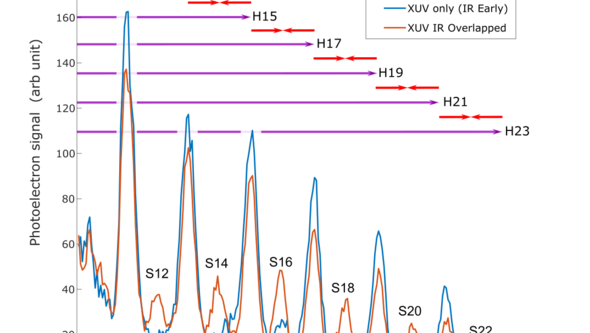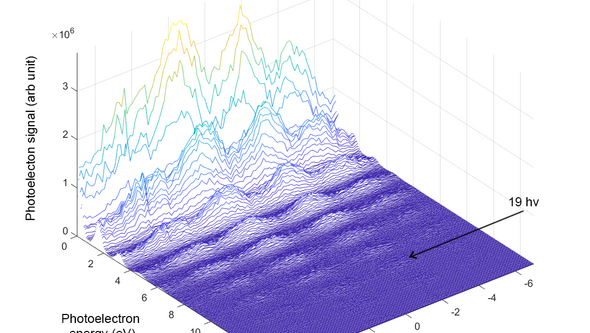
Low Density Matter Physics
Short description
The Low Density Matter – Structure and Dynamics group of Professor Raimund Feifel is active in several areas of photon science as described below, involving some of the world’s foremost multi-particle coincidence techniques in atomic and molecular physics which are constantly developed within this research environment. The group currently constructs Gothenburg’s first Attosecond Science Facility Attohallen based on a cutting-edge femtosecond OPCPA laser system.
Attohallen updates: Commissioning of the XUV-IR interferometer
Our ongoing work to commission our high pulse energy attosecond beamline achieved a significant milestone. We have successfully demonstrated the ability to perform pump-probe measurements using our newly built, grazing incidence interferometer with tests utilising both XUV-IR and IR-IR two pulse schemes, placing RABBIT measurements on new species firmly within our grasp.

Fig. 1 Sideband generation in Xenon using XUV + IR using our grazing incidence interferometer. Photoelectron peaks corresponding to the harmonic energies (H11-H23) are observed for all delays, whereas sidebands (S12-S22) are generated only when the two pulses overlap in time.

Fig. 2 Above threshold ionisation (ATI) in xenon using two time-delayed infrared pulses. The maximum ATI order (corresponding to 19 absorbed photons) is observed when the two pulses are perfectly overlapped. The oscillations in the peaks are caused by destructive/constructive interference as the pulses are delayed relative to each other, leading to an oscillating intensity.
Ultra-stable and versatile high-energy resolution setup for attosecond photoelectron spectroscopy
Our ongoing collaboration with the group of Anne L'Huillier at the Lund Laser Center, Lund, Sweden has contributed to the commissioning and testing of the latest iteration of their attosecond interferometry setup utilizing our magnetic bottle electron spectrometers, with a demonstrated stability of 13 as RMS. The system is described fully in Advances in Physics X : https://doi.org/10.1080/23746149.2023.2250105
Symmetry breaking in core-valence double ionisation of allene

As part of our project studying multiply ionised reactive intermediates, we observed an intriguing case of symmetry breaking in carbon 1s core-valance double ionisation process in the reactive molecule allene. Distinct changes in the spectrum were observed, depending on if the core ionisation occurred from the same or a different atom to the valence ionisation, which could only be explained using new theoretical approaches. These results were published in Communications Chemistry: https://doi.org/10.1038/s42004-023-00934-1

International outlook
The environment of the group is truly international, both in its composition and the way research is carried out. Complementary to in-house research activities, the group frequently leads and collaborates on experiments carried out at national and international light sources, like the synchrotron radiation facility BESSY-II in Berlin, the Free-Electron Laser facility FERMI in Trieste and the Lund Laser Center.
Many of the group’s experimental research activities are supported by theoretical modelling primarily carried out by collaborating experts, and most recently also by some of the group members.

Multiply ionised reactive intermediates
Reactive intermediates are atoms and molecules which exist only briefly under normal conditions before they undergo further reaction. These species and their ionised forms play a central role in the interstellar medium, the earth’s and other planetary atmospheres, and in plasmas, and are relevant to practical applications such as matrix-assisted laser desorption ionisation mass spectrometry and the fine control of plasma etching processes.
To date, only photoelectron spectra representing their singly-ionised forms are known; the overall aim of this project is to measure the spectra and decay dynamics of doubly and more highly charged ions derived from reactive species, an essentially new field which we just started.
The project capitalises on an exceptional opportunity to combine our experience of multi-electron-ion spectroscopic techniques with established methods for the production of reactive species, and with vacuum ultraviolet and X-radiation provided by state-of-the-art light sources for ionisation." -> "The project capitalises on an exceptional opportunity to combine this technique with established methods for the production of reactive species, which we get advised on by pioneers in the field, and with vacuum ultraviolet and X-radiation provided by state-of-the-art light sources for ionisation.
This project is primarily financed by the Swedish Research Council (VR).
XUV and X-ray ultrafast spectroscopy
The recent advent of Free-Electron Laser sources operating in the XUV and X-ray spectral region, like FLASH in Hamburg, the Linac Coherent Light Source (LCLS) at Stanford, the SCSS and SACLA facilities in Hyogo, and FERMI in Trieste, in parallel to the continuing technical advances in the creation of (sub-) femtosecond radiation pulses with high harmonic generation (HHG) sources have turned the dream of recording molecular movies with femtosecond temporal and atomic scale structural resolution into reality.
Fundamental questions which are at the heart of ultrafast photo-dynamics of molecular and cluster systems, in particular in photoinduced chemical reactions, are:
- What is the timescale for the reaction?
- Can we watch the making and breaking of chemical bonds in real time?
- Is it possible to catch some intermediate species?
- Is it possible to manipulate and control the system by varying some instrumental parameters?
From a technical point of view, answers to these questions can be obtained by ultrafast time-resolved pump-probe photoelectron-photoion spectroscopy as very recently demonstrated by us and many collaborators with one of our multi-particle correlation spectrometer stations frequently employed by FERMI. In fact, this has just become an exciting new field at the boundaries between atomic, molecular and cluster science, which is expected to have a profound impact on our understanding of chemical reaction mechanisms and chemical reaction dynamics in general.
Moreover, the same instrumentation has been used by several of our collaborators in order to demonstrate novel attosecond timing capabilities of FERMI which are complementary to table-top high-order-harmonic generation sources.
This project received primarily funding from the Swedish Research Council (VR) and the Knut and Alice Wallenberg Foundation, Sweden.
Multiple detachment of negative ions
Negative ions (anions) are quantum systems formed by neutral atoms or molecules capturing one or several additional electrons. Mono-anions may be dipole-bound, with near zero electron affinities, or valence-bound with positive electron affinities of up to a few eV. Dianions, which are particularly interesting to us, exist as polyatomic species only and may even have negative electron affinities as they are stabilized against auto-detachment by repulsive Coulomb barriers.
Because electrons in negative ions feel less Coulomb attraction to the nucleus than those in neutral or positive species, electron correlation plays a more major role in their binding. The overall goal with this project is to characterise the emitted electron distributions and correlation between all the charged particles produced upon multiple detachment of negative ions. This will lead to the discovery of new electronic states of ions and neutrals and to new physics in the charged-particle dynamics of their formation, stability and destruction. In order to execute this goal, we are in the process of setting up a state-of-the-art facility for the production and manipulation of negative ions which will be combined with one of our multi-particle correlation spectrometry stations and our upcoming high power OPCPA laser system.
There is great interest in such experiments for their relevance to intense radiation environments like the Earth’s outer atmosphere and interstellar space. Also, they will test current atomic and molecular structure theories to their limits, far beyond the frequently used independent particle model.
This project is primarily financed by the Olle Engkvist Byggmästare Foundation, Sweden.
Attosecond chronoscopy of electron emission processes
If an atom, molecule or surface absorbs a photon of sufficiently high energy, an electron may be ejected. This ‘photoelectric’ effect marked the foundation of quantum mechanics and has been tacitly regarded as instantaneous until very recently, when newly available attosecond light pulses enabled measuring real delays in the physical process.
The development of such attosecond-precise time measurements offers the opportunity for a revolution in atomic and molecular physics as interpreted by quantum mechanics, where the issue of time as an observable is a longstanding challenge. The overall aim of this project is testing the quantum mechanical description of time-dependent phenomena.
This will be done here in Gothenburg by characterizing both in phase and amplitude electron wave-packets primarily ejected from negative ions to answer fundamental questions, which are guided by time-dependent many-body theory developed by our collaborators. In order to make that happen, we are in the process of setting up, in close collaboration with the Lund Laser Center, a completely new and for Gothenburg the first attosecond science facility called Attohallen which will comprise a cutting-edge high power OPCPA laser system with two output arms feeding two high-order-harmonic generation beam lines, of which one will be optimized for high photon flux and the other for high pulse repetition rate, a state-of-the-art facility for the production and manipulation of negative ions as well as multi-particle correlation spectrometry stations.
In parallel, attosecond time-resolved photoionization experiments on neutral systems led by our collaborators at the Lund Laser Center are carried out where one of our multi-particle correlation spectroscopy station is used.
This project is primarily financed by the Knut and Alice Wallenberg Foundation, Sweden.